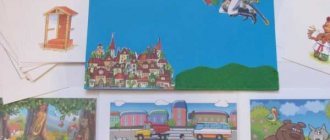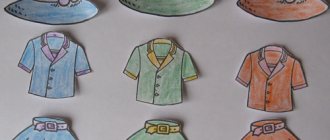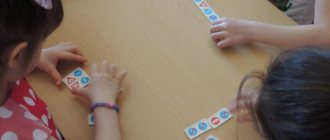Sensory perception is aimed at developing sensations and creating a system of reactions to them. Considering that the formation of sensory culture occurs at a deep level of the subconscious, it is necessary to find subtle teaching methods. Simply telling the theory and showing how to behave is an ineffective plan. Sensory education should take place in the process of different types of activities. Didactic games for sensory development turned out to be especially successful.
Sensory education of children through didactic games
Sensory is the ability to sense external influences and stimuli. This concept includes a wide variety of sensations. The importance of sensory perception is confirmed by the fact that it is placed on the same level as mental development.
Educational games
Didactic games for preschoolers are a type of thematic activities that are built in accordance with the principles of pedagogy and are a means of self-education. Sometimes preparatory steps are required to introduce a lesson or obtain a theoretical basis.
The role of didactic games in the sensory development of young children
If you integrate didactic classes, they will help to form an understanding of the external properties of objects and phenomena. For example, characteristics include shape, color, size, position in space, change over time, tactile properties, smell, taste, and more. In addition to the development of all forms of perception, didactic exercises are aimed at actively training fine motor skills of the hands.
Sensory development of young children through didactic games is a priority direction in activities in preschool classes, since it not only shows high results, but is also liked by children.
Important! Developing sensory skills is not just the job of certified teachers. Parents should provide all possible assistance for the educational process. Sensory development of children 2-3 years old through didactic games is also available at home, so classes can be continued outside the preschool. It is recommended to first attend a consultation or an open lesson with a teacher in order to do everything correctly.
Exercises for tactile memory
Sensory classes through didactic games can begin at 2-3 years old, at this time the baby’s brain is very plastic and is able to perceive concepts that are complex at first glance. The main thing is to conduct home training on a positive wave, do not get nervous and do not yell at the child if something does not work out, but you need to praise even for minor success - this will be an excellent motivation for further efforts.
Numerous forms and methods of work can be used.
- Magic bag. The mother takes an opaque fabric bag into which she places objects familiar to the child. It could be a ball, a cube, beads. The baby’s task is to reach into the bag with his hand, feel for the object and guess what it is. This game will help improve tactile sensations.
- The next step is to offer to find a given figure in the bag. Mom asks: “Get the cube.” The baby must feel it and remove it.
- To develop tactile memory, the game “Find a Pair” is suitable, the material for which is easy to prepare with your own hands. Several objects with different surfaces are laid out on the table. This can be smooth foil, sandpaper, cardboard, sponge, or a piece of fabric. The main condition is that there should be two of each type of surface (for example, smooth cardboard and silk, rough sandpaper and the hard side of a dish sponge). The child must find the pair by touch. After several training sessions, the task becomes more complicated - now the objects are hidden (you can simply cover the table with a towel), the baby needs to feel each of them and say what surface it has, and also guess what it is.
Don’t think that everything will be simple; in practice, children’s sensory development can take years. But if you practice regularly, you will notice success. The child will not only begin to navigate various types of surfaces, but will also gradually remember the characteristics: smooth, rough, slippery, soft and hard.
Lesson objectives
Sensory development through didactic games has the following features:
- teaches you to perceive the world around you through all your senses;
- forms a system of basic actions that are a reaction to external stimuli;
- teaches you to explore the world around you;
- forms a system of sensory patterns;
- teaches you to independently apply sensory patterns depending on the situation.
The child learns about the world around him through sensations. Therefore, the ability to perceive all channels of information, not limit one’s own feelings and interpret them correctly will be useful for children’s development. Sensory culture is the key to comprehensive development, successful activity, and the formation of a thinking personality that strives to understand the world around us.
Card index of games on life safety for senior and preparatory groups according to the Federal State Educational Standard
Note! Also, without sensory development, it will not be possible to teach a child to understand art and find beauty in it.
Example of educational games
Touching sensual strings
If a child’s level of voluntary processes is not sufficiently developed, then classes in a child care center, and then at school, will not give high results. But we all want to see our fidget in the ranks of the first students, we want school to be easy, and the child’s level of knowledge to increase.
Today we will talk about how to help a child achieve a sufficient level of development of sensory systems, and how to use this in classes with children under 4 years old.
The basis of a little person’s life is still the perception of the surrounding world at the level of impact on the psyche with vivid images. Knowledge begins through perception. The child’s psyche is designed in such a way as to assemble the surrounding reality into a single picture of the world with the help of:
- Vision
- Rumor
- Smell
- Touch
- Taste
All these senses are actively involved in the developmental process; these are the most relevant ways of learning new material.
N.B.
What kind of sensory games do you do with your children? Do you come up with these games yourself? Please note that the exercises must cover each of the analyzers
Card index of didactic games for sensory development of children 2-3 years old
A sensory lesson in the 1st junior group according to the Federal State Educational Standard is held to teach children basic colors, shapes and sizes.
"Button House"
Goal: training the skill of recognizing and distinguishing colors.
Materials: a circle divided into 4 multi-colored sectors, with four buttons to match each sector.
Progress: the teacher explains that each button must find its own home, which matches its color. The child selects a button and places it in the desired sector. The color is called out loud.
"Color Field"
Goal: training the skill of recognizing and distinguishing colors.
Material: circle with colored sectors (number of colors to choose from), which has an analogue of a hand, like in a watch. Children are given a set of cards where the colors match the sectors in the circle.
Progress: the teacher rotates the arrow and shows the color. Children choose the one they want from their cards and show it.
"Air balloons"
Goal: training the skill of recognizing and distinguishing colors.
Materials: several balloons of different colors and ribbons to match them.
Progress: the child is asked to match each ball with a ribbon of the same color.
“What kind of figure is this?”
Goal: to teach the child to find figures in things and objects around.
Materials: cardboard square, triangle and circle.
Progress: the teacher shows the figures one by one and asks the child to walk around the room and find objects that would be similar to them. These could be wheels, an aquarium, plates, a cabinet. You can complicate the task by specifying the color of the objects to look for.
"Hide from the Rain"
Materials: 4 cardboard squares, circles and triangles, as well as three cut out umbrellas.
Progress: the teacher lays out a template, under each umbrella there is one figure. The following describes the game situation: it has started to rain, but the pieces can only hide under their umbrella. The child moves the cards to the correct place.
Important! The teacher is an active participant in each game. Unlike other activities, here he cannot be observed from the outside. The teacher conducts a sensory lesson in the first junior group, directs it in the direction that would better accomplish the task.
Umbrella games have several variations
Game methods for forming ideas about color
The main focus is on color recognition exercises and games. With their help, a preschooler can become familiar with the generally accepted system of shades and color tones, which are included in the form of transitional phrases.
These games are very important, because children, when perceiving color in the environment, drawing it with paints and pencils, are not able to independently learn to systematize shades and tones.
G.S. Shwaido offers his own model for constructing games for color discrimination and recognition. First, the child must remember colors that are close to each other. Then he must learn to distinguish colors by dark and light shades.
After this, children should learn to distinguish between shades of one color. First, choose two shades. Then several.
To firmly grasp sensory standards, you need to repeat games many times. But repetition needs to be organized in different ways. If you repeat didactic games without changes, this will give children the opportunity to consolidate acquired skills and knowledge during the exercises.
But if you make familiar games a little more complicated, it develops interest in them. Solving new problems brings children a sense of satisfaction and joy, and children are fueled by a desire to be mentally active.
Card index of games on sensory development for the 2nd junior group
Didactic games can be combined with fine arts lessons. It is not necessary to study according to templates, since the production of the material can be entrusted to children. We must not forget that children's play should remain light and relaxed.
Note! It is necessary to exclude situations where entertainment turns into exercise, otherwise it can cause rejection in children.
Card index of topics for conversations in the senior group and for situational conversation
"Nuts in the Nest"
Goal: development of fine motor skills of the hands, exercise for fixing colors.
Materials: egg carton, paints, brushes, jar of water, peeled walnuts.
Progress: the child makes a house for nuts. Each compartment in the egg carton is painted a different color. Then the nuts are decorated. The next task is to move the nut to the appropriate house.
"Palms"
Goal: develop the ability to find a pair, correlate colors, patterns and sizes.
Materials: cut out palms of different shapes and sizes. They should be multi-colored and patterned.
Progress: the child must arrange all his palms in pairs.
"Magic bag"
Goal: to develop the ability to determine the shape of objects by touch.
Materials: bag, small cubes, balls and other shapes, maybe flat, cut out of cardboard.
Progress: the teacher names the form, and the student quickly pulls it out of the bag.
"Build a Truck"
Goal: consolidation of knowledge about the shape and size of an object.
Materials: cardboard and scissors.
Progress: at the beginning of the lesson, children cut out the required number of shapes, from which they will then need to fold a truck (two circles, a rectangle and a square). The teacher shows how they can be folded into a vehicle, and the children repeat. The figures can be glued onto cardboard and then decorated.
Card index: sensory games for the middle group
It is assumed that children already have basic knowledge of shape, color and size. Therefore, sensory classes in the middle group can require a lot of time, and can also be combined, that is, aimed at developing several skills at once.
Note! The same games can be used in the older group.
"Coins"
Goal: to consolidate knowledge about the circle, to teach how to determine the size of objects by eye.
Materials: paper cups with holes in the bottom, coins of different sizes.
Procedure: first, the teacher cuts out a circle at the bottom of each cup that would correspond to one coin. The child matches objects with prepared holes. The teacher makes sure that smaller coins do not fit into the larger holes.
Other forms can also be correlated
Formative environment and game methods
According to R.A. Kurashova, we can highlight a subject-based developmental environment, which is one of the conditions for the development of sensory standards in preschoolers.
Today, as the education system improves, as the principles of humanization of the educational process are introduced, great importance is attached to the creation of a formative environment.
The environment, which includes the child's environment, consists of the family, immediate environment and social environment. The environment can both enhance and inhibit a child’s development. But she cannot but influence his development at all.
The developing subject environment is a complex of objects of the material world with which the child interacts. It allows you to model the content of the child’s physical and spiritual appearance.
In order for didactic games to produce results, you need to follow general didactic principles in their organization.
For example, one must adhere to the principle of consistency and systematicity, which is manifested in the fact that the knowledge system should be transmitted to children in a logical sequence, taking into account the cognitive capabilities of students. Another principle is the principle of learning. It involves organizing a process of several steps. It produces more results if you take fewer breaks, stay consistent, and avoid uncontrollable moments.
Based on all this, didactic games should be carried out sequentially from simple to complex.
According to V.N. Avanesova, during classes that are based on the direct influence of adults on the teacher, it is impossible to implement all the goals of sensory education: didactic games still play a large role.
The researcher believes that in some cases games are a specific playful form of conducting classes. They can be organized with all preschoolers during classes. In other cases, games should be used in everyday life, when the child plays independently.





